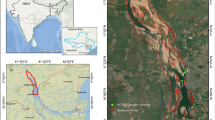Abstract
A detailed study and experimental work performed to establish the properties of multispectral remote sensing techniques as applied to the monitoring of water quality, is hihhly desirable since direct synoptic field measurements concerning the quantity and type of pollutants in water is not possible at present.
The multispectral characteristics of the signal received from water are a function of hydrological, biological and chemical characteristics of water, and the physical properties of the remote sensor related environment. Spectral data encompassing of the spectral region 0.36 μm and 2.36 μm showed that the detectibility of water pollutants, using spectral signatures in the 0.4 to 0.9 μm range, is promising and feasible.
Similar content being viewed by others
References
BLANCHARD, B.J. and R.W. LEAMER, 1973. Spectral Reflectance of Water Containing Suspended Sediment. Remote Sensing and Water Resources Management, Proceedings No. 17: 339–347.
BLYTH, K., 1981. Remote Sensing in Hydrology. Report No. 74, Institute of Hydrology, Wallingford
BOLAND, D.H.P., 1976. Trophic Classification of Lakes Using Landsat I (ERTS I) Multispectral Scanner Data. Environmental Research Lan., Office of Research and Development, US-EPA.
BROWN, W.L., 1972. Calculating Water Quality Parameters Using Remotely Sensed Scanner Date. Proc. 8th Symposium Remote Sensing of Environment, Ann Arbor, Michigan: 563–567.
CONRAD, A.C. and K.A. ROTTEWEILER, 1971. Water Quality Measurements with Airborne Multispectral Scanners. Joint Conference on Sensing of Environmental Pollutants, Palo Alto, California, AIAA Paper No. 71-1096.
DEKKER, A.A., 1985. Toepassing van Remote Sensing in Ecohydrologisch Onderzoek van Open Water Systemen. Internal report, Institute of Earth Sciences, Free University, Amsterdam.
EGAN, W.G., 1972. Water Quality Determination in the Virgin Islands from ERTS-A Data. In: Proc. of the VIII Remote Sensing Symposium, Michigan: 685–707.
HENDRIKS, M.R., E. SEYHAN and I. SIMMERS, 1985. Determination of Grid Scales of Landscape Variables for Hydrological Regionalization. Proc. of the First International Conference on Geomorphology, Manchester, 15–21 September.
HULBURT, E.Q., 1943. Propogation of Radiation in Scattering and Absorbing Medium. Journal of the Optical Society of America, 33: 42–45.
MILLER, W. and A. RANGO, 1984. Using Heat Capacity Mapping Mission (HCMM) Data to Assess Lake Water Quality. Water Resources Bulletin, Vol. 20 4: 493–501.
POLYCN, F.C. and D.R. LYZENGA, 1973. Multispectral Sensing of Water Parameters. Remote Sensing and Water Resources Management, Proceedings No. 17: 394–403.
RITCHIE, J.C., F.R. SCHIEBE and C.M. COOPER, 1983. Spectral Measurements of Surface Suspended Matter in an Onbow Lake in the Lower Mississippi Valley. J. of Freshwater Ecology, 2: 175–181.
RITCHIE, J.C., F.R. SCHIEBE and C.M. COOPER, 1984. Management of Surface Suspended Sediment in Lake Chicot Using Remote Sensing Techniques. USDA-ARS Internal report.
RITCHIE, J.C., F.R. SCHIEBE and J. HARRISON, 1983. Summary of Remote Sensing Studies on Lake Chicot. Proc. of the Arkansas Lakes Symposium, Lake Chicot.
SCHERZ, J.P., 1971. Remote Sensing Considerations for Water Quality Monitoring. Proc. 7th Symposium Remote Sensing of Environment, Ann Arbor, Michigan: 1071–1087.
SEYHAN, E., 1972. Potential Use of Remote Sensing Techniques in Hydrology. NIWARS Publication No. 3, Delft.
SEYHAN, E., 1974. Measurement of Spectral Signatures for Water Quality Monitoring. NIWARS Internal Report, Delft.
SEYHAN, E., N.J. BUNNIK, W. VERHOEF and J. VAN KUILENBURG, 1974. Measurement of Spectral Signature in Water Quality Monitoring. Proc. of the First General Conference of the Remote Sensing Society, Birmingham.
SEYHAN, E., A.A. VAN DE GRIEND and M.R. HENDRIKS, 1985. Role of Multivariate Statistical Techniques in Hydrological Regionalization and Runoff Formulation. Proc. of the First International Conference on Geomorphology, Manchester, 15–21 September.
SILVESTRO, F.B. and K.R. PIECH, 1969. Project AQUA-MAP II, Development of Aerial Photography as an Aid to Water Quality Management. Cornell Aeronautical Lab. Inc., Buffalo, California.
SIMMERS, I., 1984. A Systematic Problem Oriented Approach to Hydrological Data Regionalization. Second Iraqi IHP-Conference on Hydrological Problems of Arid and Semi-arid Regions, February 21, Baghdad.
SIMMERS, I., J.J. VAN DER SOMMEN and M. BOTH, 1982. Regionalization of Hydrologic Data: A Dynamic Modelling Approach. Proc. Symp. Hydrol. Research Basins, Bern, Vol. 3: 983–992.
SIMMERS, I. and E. SEYHAN, 1983. Hydrological Regionalization. A Question of Problem and Scale. Proc. EPA Storm Water and Water Quality Model Users Group Meeting, Gainsville, Florida, June 15.
SUITS, G.H., 1973. Preliminary Results of Water Reflectance Calculations Using AQUACAN. ERIM Memo, Ann Arbor, Michigan.
VAN LIERE, L., P. KOUWENHOVEN and L. VAN BALLEGOOIJEN, 1985. Waterkwaliteits Onderzoek Loosdrechtse Plassen. WQL-Rapport, 1985- 11, Nieuwersluis.
VAN WIRDUM, G., 1982. Toepassing van Remote Sensing in Waterkwaliteits Studies. Remote Sensing Nieuwsbrief Nr. 12, Januari.
Author information
Authors and Affiliations
Rights and permissions
About this article
Cite this article
Seyhan, E., Dekker, A. Application of remote sensing techniques for water quality monitoring. Hydrobiological Bulletin 20, 41–50 (1986). https://doi.org/10.1007/BF02291149
Issue Date:
DOI: https://doi.org/10.1007/BF02291149




